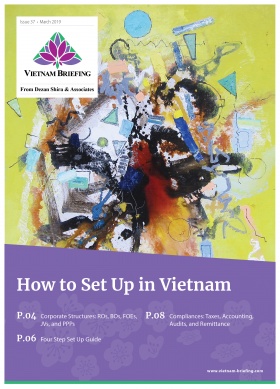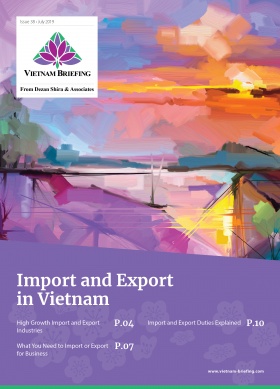Vietnam-Russia Bilateral Ties Deepen, Boost Investment
Russia was one of the first countries to establish diplomatic relations with Vietnam, laying the groundwork for a strong bilateral and economic relationship between the countries. Vietnam and Russia set up a strategic partnership back in 2001 and elevated this relationship to a comprehensive strategic partnership in 2012 paving the way for increasing economic ties.
The Vietnam-Eurasian Economic Union Free Trade Agreement (EAEU) which took effect in October 2016 lifted trade and economic ties to a new level. Last year, the trade turnover between the two countries increased by 28.6 percent year-on-year while exports from Russia to Vietnam more than doubled.
The total export value to Vietnam reached US$2.1 billion while Vietnam’s exports to Russia topped US$2.44 billion – up 12.8 percent year-on-year.
In the first four months of this year, the trade turnover was worth US$1.52 billion – up by 5.92 percent year-on-year. Leaders in both countries are aiming to achieve US$10 billion in bilateral trade by 2020.
While Vietnam and Russia are far apart geographically, there are increasing business opportunities between the two.
Russian FDI into Vietnam
Russia ranks 24 among 129 countries and territories investing in Vietnam, with 123 registered projects – mainly in oil and gas. The total registered capital of these projects is US$932 million.
Russia’s largest company in electronics, ROSTEC is one of the biggest and oldest Russian investors in Vietnam, providing the country with military engineering and technology. In recent years, the company has been expanding its investment in other civilian fields like healthcare, automotive, agriculture technology and more. According to their statement, their share of civilian products in the total revenue will exceed 50 percent by 2025 in Vietnam.
Pillars of Vietnam-Russia cooperation
Russia’s main exports to Vietnam include grain crops, food products, mineral raw materials, and metals. Russia is also the largest supplier of military arms and equipment to Vietnam – equipping the country with modern high-tech weapons for security and defense.
Vietnam’s main export to Russia includes electrical engineering products, mobile phones, textiles, food and beverage, and coffee. Of the most important pillars of Russia-Vietnam economic ties is the energy (oil and gas) sector. The agriculture and food, and tourism industries are also becoming increasingly important in the bilateral trade and economic relationship of the two countries.
Vietnam has 22 investment projects in Russia which are worth nearly US$3 billion. One of the biggest and most notable Vietnamese investment include TH Groups’ US$2.7 billion in dairy farms in the Primorye region.
Energy
Oil and gas exploration and exploitation have been an important pillar of Vietnam-Russian economic cooperation. The Russian-Vietnamese enterprise Vietsovpetro is the eighth largest company in Vietnam and produces one-third of the country’s oil. In the first five months of 2018, the company exploited 1.8 million tonnes of oil and 81.9 million cubic meters of natural gas.
Leaders in both countries are encouraging oil and gas exploration and exploitation on the continental shelves of both countries. In May this year, Novatek, Russia’s largest independent gas producer, signed a Memorandum of Understanding (MoU) with Vietnam’s Ninh Thuan Provincial People’s Committee to develop an integrated LNG (low-tonnage liquefied natural gas) energy-generating project within Vietnam. Major Russian oil and gas groups like Gazprom and Rosneft are expected to engage in many more projects in Vietnam’s continental shelf by 2030.
The economic growth of Vietnam is driving up the energy demand of the country especially in coal, oil, and gas. The demand in the electricity sector has risen by 13 percent since 2000 and is expected to grow at 8 percent through 2030. Considering this, investors from Russia, which is one of the largest exporters of natural gas and is home to the second-largest coal reserves in the world, will find it profitable to supply to this growing market.
Agriculture, food, and beverage
In terms of food products, Vietnam’s main exports from Russia consist of confectionary, milk powder, cereals, raw materials for animal feed, alcohol, cooking oil among others.
According to the Russian Export Centre in Vietnam, increasing Russian agricultural products are making their way into Vietnam’s domestic market.
Sunflower oil, pine nuts, walnuts, and cereals are among some of the most popular Russian products in Vietnam. Russia is the top supplier of wheat to Vietnam while Vietnam is the fourth largest buyer of Russian wheat, importing around 1.7 million tons of the product in the first four months of last year.
Last month, the Association of Vietnam Retailers (AVR) organized the Vietnam-Russia Trade Connection program. 100 delegates including those from Russian production and supply enterprises, retail distribution and import-export enterprises took part, introducing Russian food products in Hanoi. Large supermarkets in Hanoi were also visited to enhance trade connectivity between the two economies.
Tourism
Vietnam is becoming a tourism hotspot for the Russians. In 2017, more than 512,000 Russian tourists arrived in Vietnam, a 30 percent increase year-on-year. Last year, around 600,000 Russian people visited Vietnam, ranking sixth among all countries in terms of visitor numbers.
Amongst the most popular destination is the coastal city of Nha Trang, formally home to Russia’s biggest naval base outside its territory. With 75 percent of its tourists coming either from China or Russia, several shops have Russian signboards, tour guides, and drivers, with even Vietnamese residents speaking Russian to cater to the increasing number of Russian visitors. The town has also been dubbed as “a little Russia”.
Russian trade has also been increasing in the town as natives of the country start their own businesses in sectors like retail and hospitality.
The total number of tourist arrivals from Russia is expected to leap by 1 million in 2020. According to the Vietnam National Administration of Tourism (VNAT), the number of arrivals of Russian tourists in Vietnam is growing by 30 percent annually on average.
In July this year, the two countries signed an MoU to build joint tourism cooperation programs.
Future of Vietnam-Russia relations
The government of Vietnam hopes for Russia’s support in developing the country’s digital government and smart cities, as well as cybersecurity. Vietnam is pushing for a higher level of data security and data connection and sharing among public agencies.
Russian leaders have emphasized the importance of establishing the country’s legal foundation (legal institutions and documents) to help build Vietnam’s e-Government. Another impediment to developing Vietnam’s e-Government would be difficulties in linking data of different ministries, sectors, and localities.
However, Russian, authorities have expressed willingness to work closely and share their experience with Vietnam through free-of-charge consultancy, technology transfer, and training of experts.
About Us
Vietnam Briefing is produced by Dezan Shira & Associates. The firm assists foreign investors throughout Asia from offices across the world, including in Hanoi and Ho Chi Minh City. Readers may write to vietnam@dezshira.com for more support on doing business in Vietnam.
- Previous Article Vietnam, Russia Seek to Boost Annual Bilateral Trade Turnover to US$10 Billion by 2020
- Next Article Incentives for Developing Infrastructure at Vietnam’s Industrial Zones






























